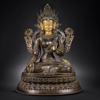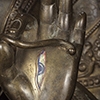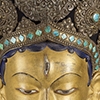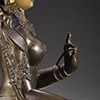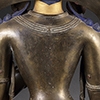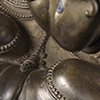Catalogue Note
The present lot epitomizes the most beautiful sculptures of Tara made under the patronage of the Yongle emperor during the Ming dynasty. In essence, the Tara in the Tibeto-Chinese style of the Ming dynasty not only constitute the pinnacles among representations of Tara and of Buddhist art as a whole, they also represent the most perfect example of casting techniques of that period. For instance, works of smaller size were often cast in two major pieces, one formulating the figure and another the base. Similar to the present lot, appurtenances such as the scarf were also often cast separately and skillfully re-assembled later on. Traditionally, the skin of the figure is often painted in the liturgically prescribed colors when a sculpture is polychrome. Similar to the present lot, gold being the favored color used on the face while black or blue were invariably used on the hair. Traditionally, gold paint was re-applied as they became discern over time. This method involved applying a mixture of gold powder and gelatin with a fine brush and was known as trang ser (gold coated) in Tibet. The turquoise inlaid adorning the crown of the present lot is also inline with the artisan's practice of encrusting their surface with semi-precious stones as it enhances the sumptuousness of their works. The artisan's preference and tendency to use blue precious stone such as turquoise inlaid can be summarized by E.H. Schefer's annotation:
“The Chinese were not alone among the Far Eastern peoples in their admiration for blue mineral. The Tibetans valued it above all others, even ahead of gold, and those highlanders saw in it the image of the azure sky, and said that the hair of their goddesses had its color.”
Tara's name translates to the one who saves and is often referred to as the manifestation of wisdom and the embodiment of prajnya (insight), worshipped by laymen and lames across centuries. In retrospect, Tara's great popularity coincided with the growth of Tantric worship early in western Tibet and subsequently have had a profound influence on Buddhism. There are essentially twenty one forms of Tara, each representing the Tara invoked in "Twenty one Verses in Praise of Tara" recited by Vairochana Buddha in the thirty five chapter of the Tara Tantra, each Tara correspond to one of the verses in the text. It is highly probable that the present lot is a depiction of Sitatara (White Tara) as the gesture of her right hand in varada mudra and her crossed leg folded in padmasana signifies a trademark of the deity. According to popular folklore, the legendary origin of Tara is related to the great bodhisattva, Avalokiteshvara. As he witnessed the ever-increasing misery of humanity, he shed an endless stream of tears of compassion streaming down his face and from the tears the White and Green Taras were born. It is from the aforementioned concepts that depictions of Tara in both
painted as well as sculptural forms have been conceived, such as the impressive images of White Tara gracing the halls of the Patala palace, constructed by the Great Fifth Dalai Lama in 1645 above Lhasa over the ancient ruins of Songtsen Gambo's castle.
In addition, the majestic grace of the deity seems to have inspired the present lot of the graceful Tara as it also constitutes one of the most exquisite depictions of the female deity and one of the most extraordinary sculpture to survive from the early periods of Buddhist art. The figure's gesture is both alert and majestic in a pose of power, further adorned with an elaborate jeweled crown with a network of royal ornaments festooned across her naked torso. The White Tara is also known as the Maiden with seven eyes. As seen on the present lot, her serene face is meticulously depicted with a third eye on her forehead, which symbolizes her direct vision of the unity of ultimate reality simultaneous with her two eyes seeing the dualistic world of beings. The eye in the palm of her hands is connotative that her generosity is always accompanied by perfect wisdom. The deity's crossed legs signify her immovability from contemplative union with Nirvana while the eyes in the sole of her feet enables a continuing wariness of all living beings' plight. It is also interest to note that the stem of a triple lotus in her hand extending to further buds and blossoms is indicative of the Buddhas of past, present and future. Compare with a closely related White Tara Stele dated to the second half of the 11th century from the Herbert and Florence Irving Collection. (Fig.1) This impressive stele depicts White Tara in a similar posture as the present lot, illustrated in Wisdom and Compassion, The sacred art of Tibet, Asian Art Museum of San Francisco and Tibet, New York, 1991, p.124, pl.22. See also another important embossed embroidery Thangka from the Tibet Museum Collection and another statue of White Tara from the Nor-bu-gling-ka Collection (Fig.2), similarly adorned with a five panel crown and decorated with precious turquoise inlays, illustrated in Jane Singer's Tibetan Art, towards a definition of style, London, 1997, pp.126-127 and 130-131.
“The Chinese were not alone among the Far Eastern peoples in their admiration for blue mineral. The Tibetans valued it above all others, even ahead of gold, and those highlanders saw in it the image of the azure sky, and said that the hair of their goddesses had its color.”
Tara's name translates to the one who saves and is often referred to as the manifestation of wisdom and the embodiment of prajnya (insight), worshipped by laymen and lames across centuries. In retrospect, Tara's great popularity coincided with the growth of Tantric worship early in western Tibet and subsequently have had a profound influence on Buddhism. There are essentially twenty one forms of Tara, each representing the Tara invoked in "Twenty one Verses in Praise of Tara" recited by Vairochana Buddha in the thirty five chapter of the Tara Tantra, each Tara correspond to one of the verses in the text. It is highly probable that the present lot is a depiction of Sitatara (White Tara) as the gesture of her right hand in varada mudra and her crossed leg folded in padmasana signifies a trademark of the deity. According to popular folklore, the legendary origin of Tara is related to the great bodhisattva, Avalokiteshvara. As he witnessed the ever-increasing misery of humanity, he shed an endless stream of tears of compassion streaming down his face and from the tears the White and Green Taras were born. It is from the aforementioned concepts that depictions of Tara in both
painted as well as sculptural forms have been conceived, such as the impressive images of White Tara gracing the halls of the Patala palace, constructed by the Great Fifth Dalai Lama in 1645 above Lhasa over the ancient ruins of Songtsen Gambo's castle.
In addition, the majestic grace of the deity seems to have inspired the present lot of the graceful Tara as it also constitutes one of the most exquisite depictions of the female deity and one of the most extraordinary sculpture to survive from the early periods of Buddhist art. The figure's gesture is both alert and majestic in a pose of power, further adorned with an elaborate jeweled crown with a network of royal ornaments festooned across her naked torso. The White Tara is also known as the Maiden with seven eyes. As seen on the present lot, her serene face is meticulously depicted with a third eye on her forehead, which symbolizes her direct vision of the unity of ultimate reality simultaneous with her two eyes seeing the dualistic world of beings. The eye in the palm of her hands is connotative that her generosity is always accompanied by perfect wisdom. The deity's crossed legs signify her immovability from contemplative union with Nirvana while the eyes in the sole of her feet enables a continuing wariness of all living beings' plight. It is also interest to note that the stem of a triple lotus in her hand extending to further buds and blossoms is indicative of the Buddhas of past, present and future. Compare with a closely related White Tara Stele dated to the second half of the 11th century from the Herbert and Florence Irving Collection. (Fig.1) This impressive stele depicts White Tara in a similar posture as the present lot, illustrated in Wisdom and Compassion, The sacred art of Tibet, Asian Art Museum of San Francisco and Tibet, New York, 1991, p.124, pl.22. See also another important embossed embroidery Thangka from the Tibet Museum Collection and another statue of White Tara from the Nor-bu-gling-ka Collection (Fig.2), similarly adorned with a five panel crown and decorated with precious turquoise inlays, illustrated in Jane Singer's Tibetan Art, towards a definition of style, London, 1997, pp.126-127 and 130-131.

